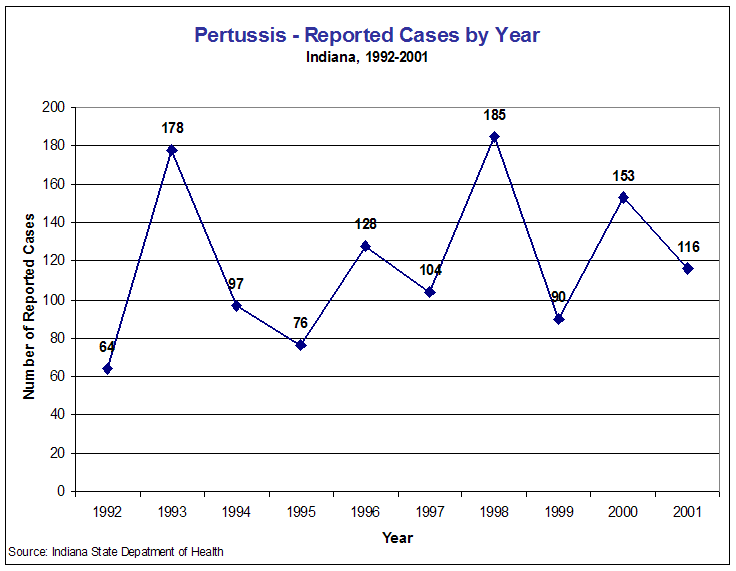Figure Per1: Pertussis - Reported Cases by Year, Indiana, 1992 - 2001

2001 Indiana Report of Infectious Diseases |
View ISDH's Quick Facts on Pertussis
View CDC's Pertussis information
Rates presented are per 100,000 population and are based on the 2000 U.S. Census.
| Cases | Incidence Rate |
|
| Total | 116 | 1.9 |
| Race-specific cases and rates | ||
| White | 110 | 2.1 |
| Black | 6 | 1.2* |
| Other1 | 0 | |
| Sex-specific cases and rates | ||
| Female | 55 | 1.8 |
| Male | 61 | 2.0 |
In 2001, Indiana had 116 reported cases of pertussis, a decrease from 153 cases in 2000. Thirty-four counties had at least one case of pertussis during the year, down from 41 counties in 2000 (Table Per1).
Unlike other vaccine-preventable diseases, pertussis incidence has increased over the past 15 years. A mean of 86 cases per year was found for 1987-1991; a mean of 109 cases per year for 1992-1996; and a mean of 130 cases per year for 1997-2001. Figure Per1 shows the incidence of pertussis by year for the past 10 years. This upward trend is mirrored by incidence at the national level also. It is generally believed that this long-term increase is attributable to better recognition and reporting of suspected cases. The reported cases by month are shown in Figure Per2.
Laboratory confirmation was available for 40 cases (34.5% of all cases); 22 cases were confirmed by culture and 18 were confirmed by polymerase chain reaction (PCR). The remainder of the cases were linked to laboratory confirmed cases and/or met the case definition for pertussis.
Pertussis is the most frequently reported vaccine-preventable disease among children under age 5. In 2001, 35 cases (30.2% of all cases, case rate = 41.4/100,000 population) occurred in infants under age 1 and nine cases occurred in those ages 1-4 (7.8% of all cases, case rate = 2.7/100,000 population). Since waning immunity following natural infection or vaccination occurs, pertussis can affect persons of any age. In 2001, there were 37 cases (31.9% of all cases and case rate = 4.1/100,00 population) reported in those ages 10-19. Figure Per3 depicts the percent of cases in selected age groups.
Females accounted for 55 (47.4%) cases with males accounting for 61 (52.6%) of cases. By race, whites accounted for 110 cases (94.8% of all cases, case rate = 2.1/100,00) and Black/African American for 6 cases (5.2% of all cases, case rate=1.2/100,000).
Unvaccinated children are at highest risk for severe disease, but fully immunized children may also develop disease. Vaccine efficacy for the currently licensed vaccines is estimated to be 71-84% for preventing serious disease. Table Per2 shows the number and percent of cases that were up-to-date for pertussis vaccination at time of illness for selected age groups.
Back to Top of Article
Back to Table of Contents
Back to Reference in Text
Back to Top of Article
|
Figure Per1: Pertussis - Reported Cases by Year, Indiana, 1992 - 2001 |
|
|
Back to Reference in Text
Back to Top of Article
|
Figure Per2: Pertussis - Reported Cases by Month, Indiana, 2001 |
|
|
Back to Reference in Text
Back to Top of Article
|
Figure Per3: Pertussis - Incidence Rate by Age Group, Indiana, 2001 |
|
|
Back to Reference in Text
Back to Top of Article
|
Table Per2: Vaccination History of Reported Cases, Ages 6 Months to 6 Years, Indiana, 2001 |
||||||||||||||||||||||||||||
|
||||||||||||||||||||||||||||
Back to Reference in Text
Back to Top of Article
1 - "Other" includes American Indian/Alaska Native, Asian, Native Hawaiian/Pacific Islander, and multiracial.
* - Rate based on less than 20 cases and should be considered unstable.
Back to Table of Contents
[an error occurred while processing this directive]